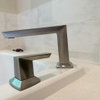Water Softener Sizing Help
bmickyd
11 years ago
Related Stories

GARDENING GUIDESGreat Design Plant: Northern Maidenhair Fern Softens Shade Gardens
Stir up some romance in dark corners with the billowy fronds of native Adiantum pedatum
Full Story
GARDENING GUIDESGreat Design Plant: Palo Blanco Softens Sharp Desert Angles
Willowy foliage and creamy white bark give this tree a delicate beauty, but its constitution is tough
Full Story
GREEN BUILDING4 Ways Green Roofs Help Manage Stormwater
See how a living roof of any size can have a big impact
Full Story
GARDENING GUIDES8 Unthirsty Plants Help You Save Water in Style
Spend less effort and money on your landscape with drought-tolerant and native plants that liven up your yard
Full Story
LANDSCAPE DESIGNHow to Site and Size a Rain Garden for Your Landscape
Installing a rain garden is an excellent way to reduce runoff and return water to its source
Full Story
COLORPick-a-Paint Help: How to Quit Procrastinating on Color Choice
If you're up to your ears in paint chips but no further to pinning down a hue, our new 3-part series is for you
Full Story
COLORPick-a-Paint Help: 11 Ways to Mine Your World for Colors
Color, color everywhere. Discover the paint palettes that are there for the taking in nature, shops and anywhere else you roam
Full Story
GARDENING FOR BUTTERFLIESBring on the Birds: Natural Habitat Ideas for Gardens of All Sizes
Provide nesting, watering and perching spots inspired by the Costa Rican jungle and watch the birds flock on over
Full Story
DECORATING GUIDESSize Up the Right Area Rug for Your Room
The size of a rug can make an important difference to the feel of a room. Here are some tips to help you make the right choice
Full StorySponsored
More Discussions









User
bmickydOriginal Author
Related Professionals
Millbury Handyman · Fairfax Handyman · Adelphi Kitchen & Bathroom Remodelers · Cleveland Kitchen & Bathroom Remodelers · Creve Coeur Kitchen & Bathroom Remodelers · Glendale Kitchen & Bathroom Remodelers · Kettering Kitchen & Bathroom Remodelers · Manassas Kitchen & Bathroom Remodelers · New Port Richey East Kitchen & Bathroom Remodelers · Niles Kitchen & Bathroom Remodelers · Oceanside Kitchen & Bathroom Remodelers · Payson Kitchen & Bathroom Remodelers · Sioux Falls Kitchen & Bathroom Remodelers · West Palm Beach Kitchen & Bathroom Remodelers · Forest Hills Kitchen & Bathroom RemodelersUser